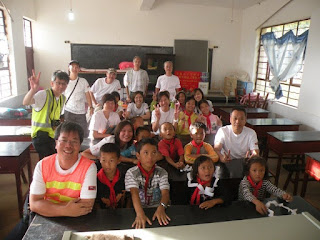Not as popularly travelled by tourists as the Silk Road, the Ancient Tea Horse Road preserves much tranquility and peace.
Dating back to the Han Dynasty and maturely developed in the Tang Dynasty, the passage was a major way for the old Middle Kingdom to trade tea, salt, sugar and other daily consumables for horses and herbs with its western neighbour Tibet, and extended further to Southeast Asian countries like Nepal and Burma.

We hiked for 10km along the Lameipo (臘梅坡) trail, which is reportedly one of the best conserved sections of the Ancient Tea Horse Road. A large stone craved with the words “Tea Horse Post” greeted us as we arrived at the starting point of the trail. Several nicely decorated houses juxtaposed at the foot of the hill, with maize hung outside the outer walls and laid on the terraces for drying under the sun, making colourful sights.
The upward slope was rather steep. But overall speaking the trail was manageable for an unskilled hiker like me. One of the oldest participants, the 70-year-old Mr. Cheung, was asked whether he really wanted to go with us. Unlike on the previous two days when we hiked on concrete lanes and when a van was available to pick up participants who lagged behind the team or needed some rest, the hill was not accessible by vehicles. The elder, however, insisted in walking for at least a while with the team. So he did it! After hiking up for some time, two members of our escort fire services team accompanied him going down the slope to the starting point. We are proud of Mr. Cheung’s effort!
The uphill section at the beginning was perhaps the most demanding part of the hike. But after taking a rest at the first pavilion we encountered, the way ahead was much flatter. We could see tea trees planted on terraces as we looked around. And as we approached the peak, we entered a big tea tree field! Blooming white flowers of tea trees greeted us with pleasant smell from both sides as we walked along the narrow path in the middle. A clear sky right above us brought us some more cheers.

Later we entered a forest. In contrast with the open space of the tea tree field, it was much dimmer as sunlight was blocked by tall trees. The ground was wet and slippery, apparently because rainwater which dropped on the day before had not yet dried up. I tripped while stepping onto a flat rock, so did some others. More participants tripped when we hiked downhill – it was really not that easy to balance there!
Mrs. Lam had an injury in her leg and was walking with noticeable difficulty. Hand in hand with her husband, who joined this trip to accompany her, she finally completed the whole route. We all gave her a round of applause at our subsequent sharing session at night.
After five hours of hike, I was excited to see a milestone with the number 1 painted on it – which indicated there was only one kilometer left before reaching the end of the trail. Despite my tired legs and the steep downward slope, I accelerated forward because… I was really hungry! We finally reached a village on the other side of the hill. Congratulations! Everyone made it!
(Photos by courtesy of my group-mate Mr. Tony Ho)

